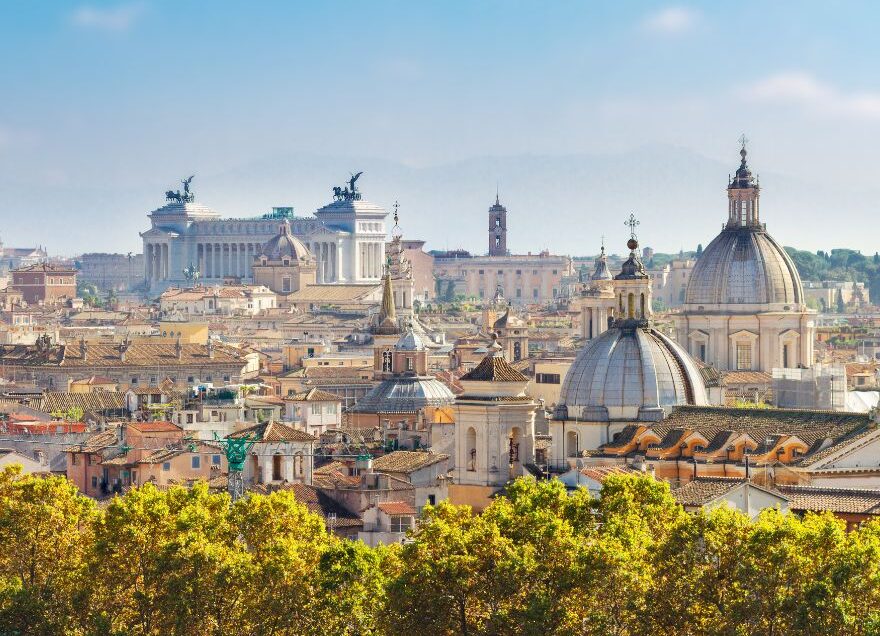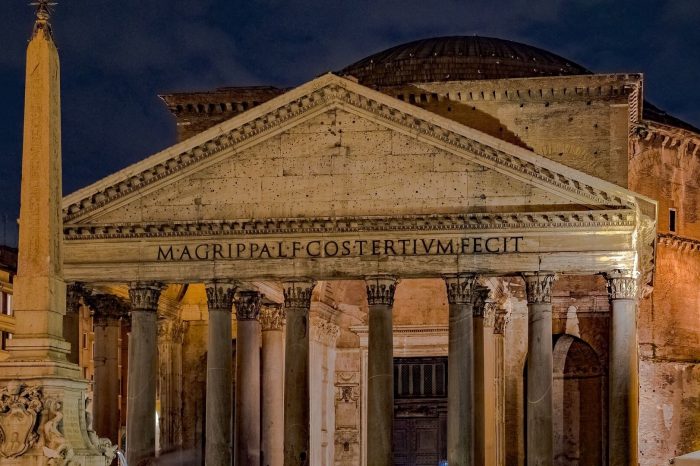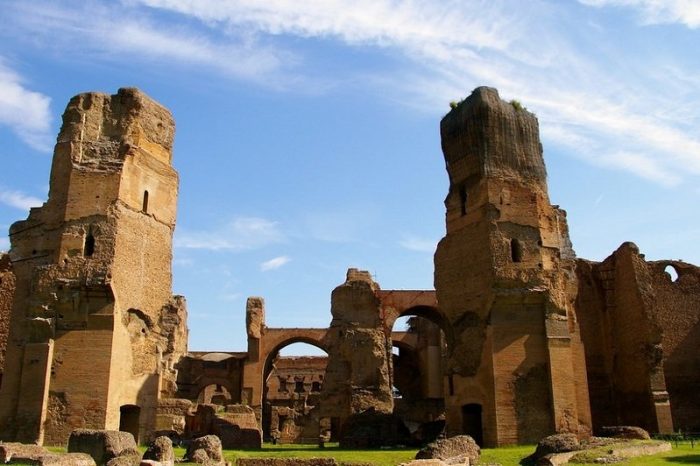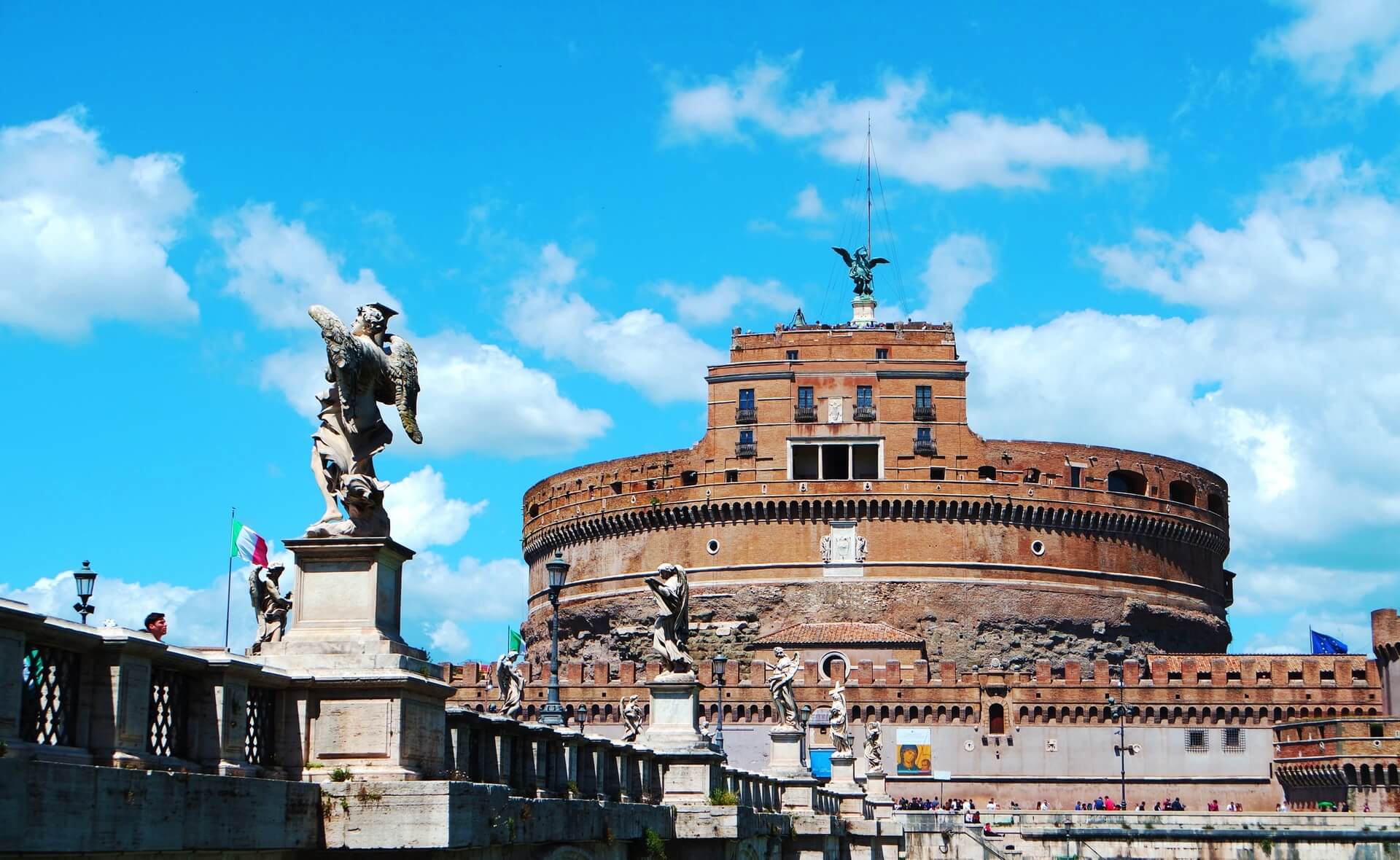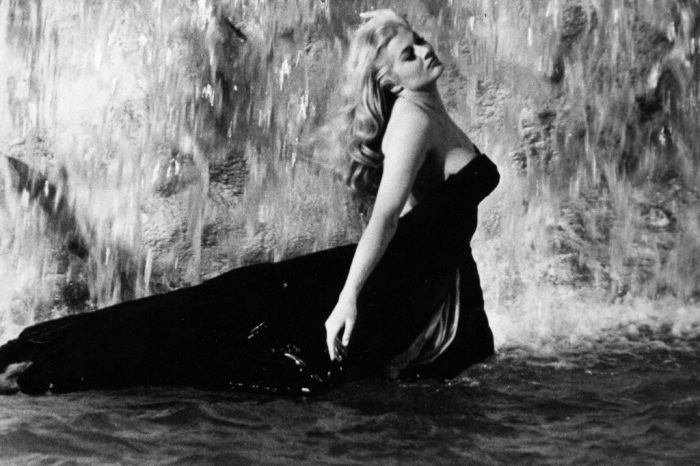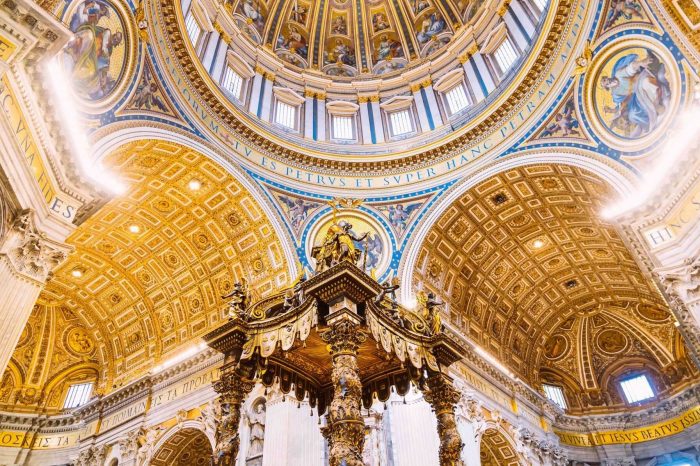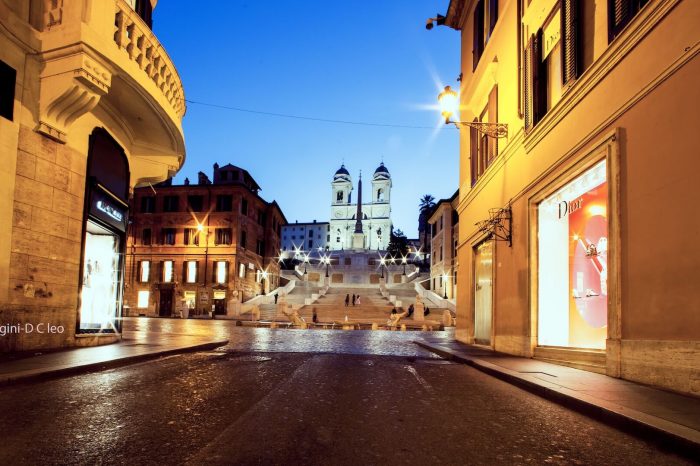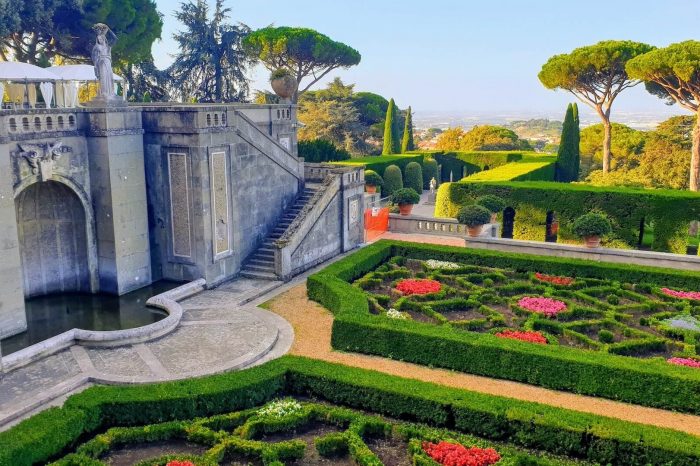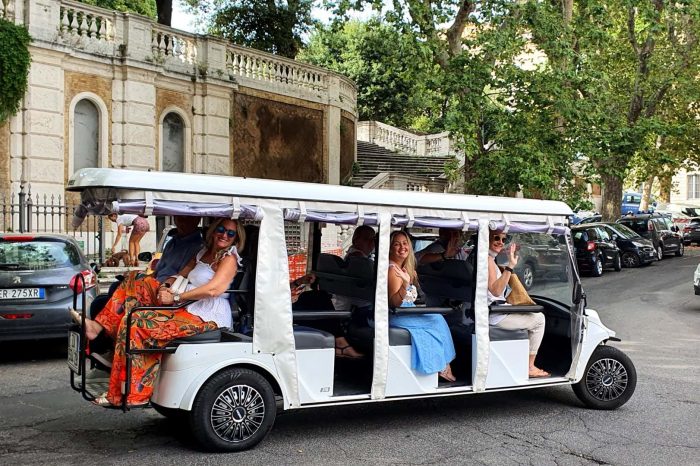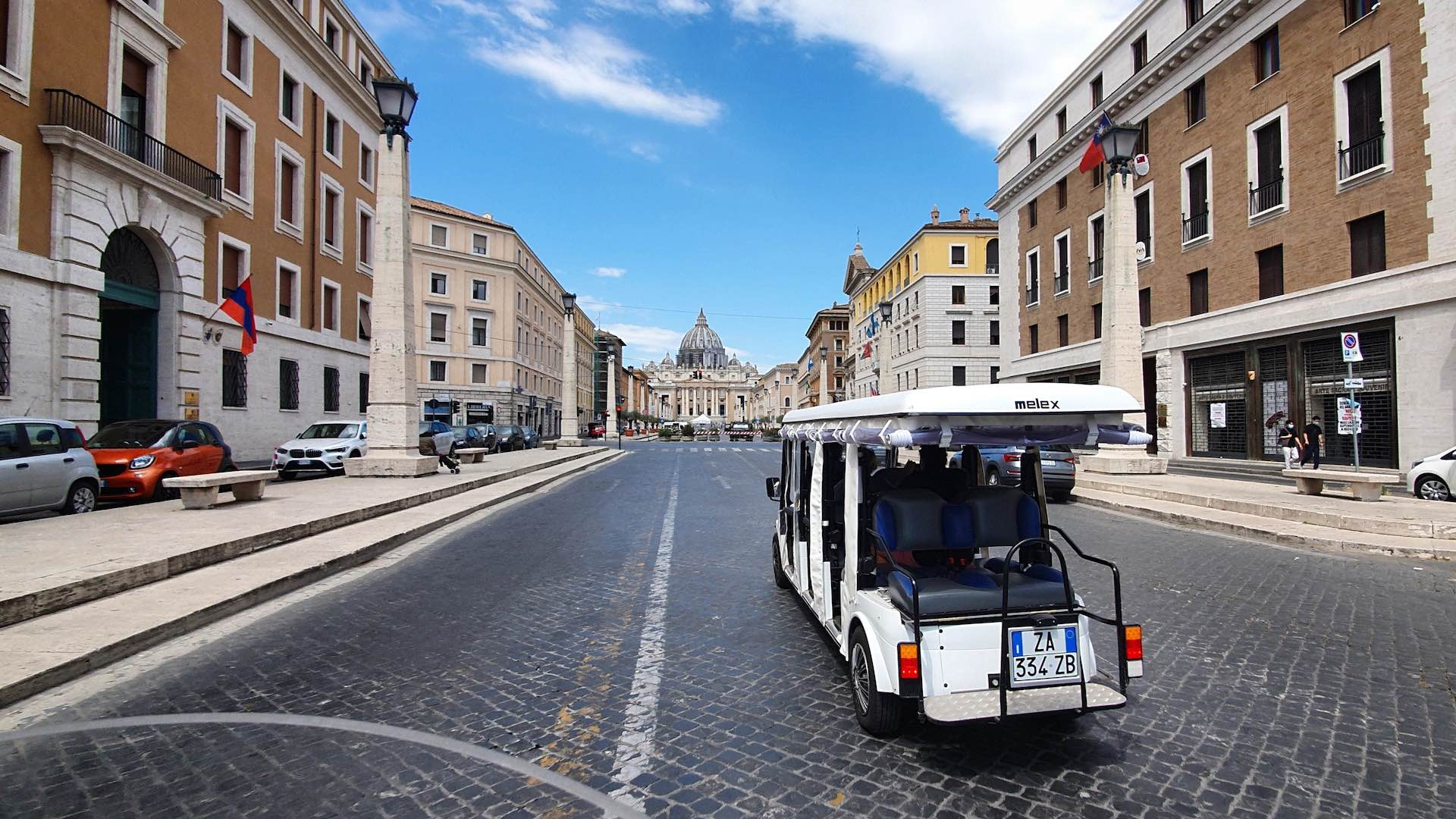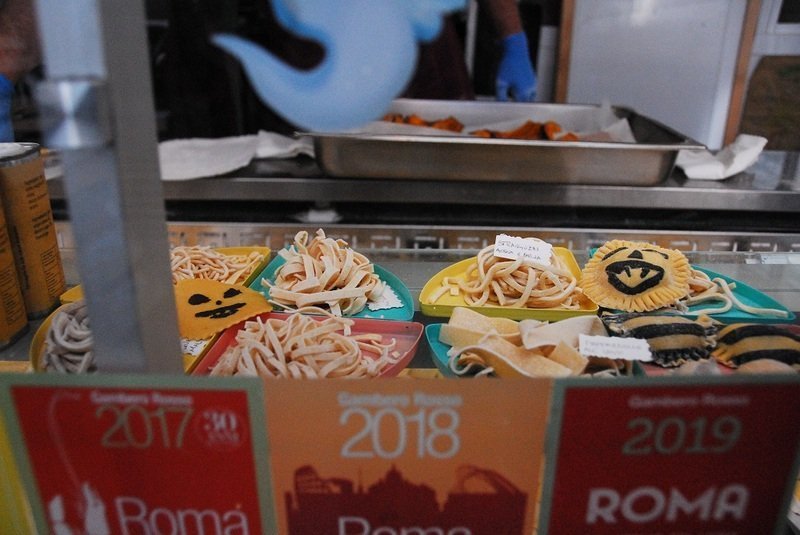Here is a question for you:
Which are the three famous monuments in Rome that come to your mind when you think about the city?
We may imagine the ‘colossal’ arches of the Colosseum (a synonym for enormous that literally comes from the spectacular size of this amphitheater), the columns of the Pantheon temple and the the remains of the Roman Forum dotted over an expanse.
However, there are not only Roman monuments in Rome but rather, the Eternal City boasts a cultural heritage with leftover monuments and relics spanning across a much richer cultural heritage, collecting legacies from every era. The influential civilization historically made so many intersections with different cultures along the way that it is brimming with diversity.
In this article we would like to guide you through the most important monuments in Rome, journeying through history and cultures. The following is what we will be covering:
Rome monuments list:
- Pantheon
- Colosseum
- Pyramid of Cestius
- Castel Sant’Angelo
- Fontana di Trevi
- St. Peter’s Basilica
- Spanish Steps
- Borghese Gallery and Museum
- Altare della Patria
PANTHEON
The Pantheon is the oldest monument in Rome that is still in active usage. It stands magnificent in the center of Rome on Piazza della Rotonda. Originally a temple, built in 27 B.C. by Agrippa and then rebuilt by Hadrian in125 A.D.* , it was used for the worship of the gods. It was later converted into a church and is still used as such, with masses and other religious activities taking place regularly.
The Pantheon is one of the best-preserved ancient buildings in Rome, having had numerous conservation efforts gone into it. It is known for having an enormous open dome skylight called the oculus that floods light into the indoor space, acting as a sundial in order to be able to tell the time. It holds tombs of several historically important figures such as King Victor Emmanuel II, Queen Margherita of Savoy, King Umberto I and the widely visited tomb of the Renaissance painter Raphael which is part of the first chapel on the right side when you enter the building. It also has seven chapels around the circular interior.
*It is important to note in efforts of being precise that the oldest monument is the Temple of Hercules Victor and dates back to the 2 B.C. where ancient Romans used to deposit objects as offerings. It is located at the Piazza della Bocca della Verità in Rome.
One of the most beautiful sights is to see the columns and pillars of the Pantheon against a dark sky at night; it seemingly glows when lit softly and makes the contrast of the temple-converted-church beautiful to gaze at.
COLOSSEUM
It can easily be argued that the Colosseum is the most famous landmark in Rome, its architecture recognized worldwide, perhaps even standing as the symbol to represent all of Italy. It was commissioned by ancient Roman emperor Vespasian from 70-72 A.D., located on Piazza del Colosseo in what is considered to be the center of the city. It was used as an amphitheater for public games such as gladiator fights, greatly contributing to cultural entertainment in Rome but also influencing socio-political values as the brutal gladiatorial lifestyle shared bounds of information about what life was like that during that time.
The Colosseum’s building was damaged by the test of time, weather conditions and even earthquakes, but still remains largely standing as the most historic place in Rome to visit, with numerous conservation efforts gone into it.
Fascinating stories and architectural journeys can still be taken by entering inside this famous amphitheater and discovering various levels of it. You can explore the Colosseum in its entirety and also specifically tour around the ruins of the arena floor.
PYRAMID OF CESTIUS
Egyptian monuments in Rome?
No. Gaius Cestius’s pyramid is actually of Roman origin. Cestius (more commonly known as Caio Cestio) was a senator and one of the magistrates in Ancient Rome. The pyramid was built in 12 B.C. as a burial site for him and is located on via Raffaele Persichetti in the Testaccio neighborhood of Rome. It is such an unusual tomb to visit, completely different from the architecture of other burial sites that can be visited in Rome, but it represents perfectly how charmed and intrigued the Romans were by Egyptian culture.
Although well-preserved and significant, the Pyramid of Cestius seldom makes it on the itinerary of tours. However, Walks Inside Rome makes a visit to observe and learn about it during our carefully curated Secret Tour of Rome.
CASTEL SANT’ANGELO
Castel Sant’Angelo is amongst the ancient monuments in Rome with some of the most fascinating histories. It is hard to miss, as it lies massive along the bends of the Tiber River on Lungotevere Castello, very close to and at walking distance from Vatican City.
It’s cyclical concrete and stone structure was initially constructed as a mausoleum for the Roman Emperor Hadrian in 135 A.D., but then later, during the decline of the Roman Empire, its versatility shone through as a fortress to be used to defend Rome from external groups trying to enter and threaten it. Its exterior makes it look more like it was for military use than for a tomb. However, another switch in activities influenced the monument, as in the 14th century it began being used as a papal residence! The f0rtified structure came in handy for the security and exclusivity of the popes, making it a perfect place for papal apartments to be situated in, also due to the closeness in proximity with the Vatican.
The list of uses does not stop there, however. Later in the 16th and 17th century it was used as a prison and then from the 20th century onward to the current period it has been converted into a museum, opening it to the public. It can be visited for panoramic views of the city, to discover the prison cells and to explore the papal apartments. The diversity in what you can see here makes Castel Sant’Angelo an unmissable experience. Perhaps the easiest way to tackle it would be to merge itineraries with a Vatican tour!
FONTANA DI TREVI
You may recognize this quintessential fountain from a world-famous Italian movie: Fellini’s 1960 film ‘La Dolce Vita’. There is a mesmerizing scene that stays embossed in the minds of those who watch it, which is of Anita Ekberg as ‘Sylvia’ in a gorgeous black dress jumping in and wading through the fountain’s water. The fountain makes a stunning background for her to invite Marcello Mastroianni’s character, Marcello Rubini, to join her.
Fontana di Trevi is one of the major monuments of Rome and also the largest baroque fountain that can be found in the city. It is located in the district of Trevi in the center, which joins three roads of the city to converge at a point with of an ancient aqueduct, which is where the water of the fountain is sourced from.
It was commissioned by Pope Clement XII as part of a competition in 1730 which was won and started by architect Niccola Salvi and then finished by architect Pietro Bracci in 1762. The fountain celebrates the abundance of free, fresh water available in the city, which truly is a unique thing to celebrate!
Perhaps the most iconic feature of the fountain is a statue of the god of the sea, Neptune, in the middle. A famous tradition associated with the fountain is to turn your back to it and flip coins over your left shoulder into it: one coin promises that you will return to Rome one day, two promises the arrival of a new love and three promises marriage!
You can immerse yourself in the world of La Dolce Vita by taking a tour specifically dedicated to it! We offer a carefully crafted experience that takes you around all of the areas and to all the monuments that make an appearance in the film. The cherry on top of this experience still lies in the visit to the luminous Fontana di Trevi, where you can imagine Ekberg’s character in the turquoise water, with her long black dress swirling around her.
ST. PETER’S BASILICA
St. Peter’ Basilica is part of some of the world’s most well-preserved sites, making it an honor to be able to witness it in real life. Its architectural value has been so revered that several restoration interventions have taken place in order to maintain it to what we can see today.
The basilica is technically located on St. Peter’s square within the Vatican City, and is surrounded by the city of Rome. It was built in the 4th century during the reign of Roman Emperor Constantine on the ground that is considered to be where St. Peter, one of the twelve apostles of Jesus, is buried. This lends the basilica holy influence, making it a site for pilgrimage in Christianity even now in current time. It however required enormous efforts in restoration and so in the 15th century it was commissioned by Pope Julius II for repairs, taking almost over a century for the restoration projects, art preservations and structural maintenance. Very important artists and architects worked on the building, such as Michelangelo and Bernini.
Today the basilica holds a central role in the religious, cultural and historical life of the Catholic Church. Many activities take place there for locals of the Vatican City, locals of Rome and tourists from all over the world, all who come for worship, masses, ceremonies and to witness papal functions like addresses and blessings by the Pope from the balcony.
It is important to note that the Vatican Museum that hold the Sistine Chapel are all concentrated in the same area within the Vatican City, and so visiting all three sites goes hand in hand. To visit is already an incredible one-in-a-lifetime experience, but to make it even more special you can visit everything before the general publics gets to see them through an early morning Vatican tour.
SPANISH STEPS
More than a monument, the square called Piazza di Spagna where the Spanish steps lie holds a collection of symbols. The square itself is the crossroads for some of the liveliest streets of Rome, all connecting to the base of these steps where there is the well-known fountain Barcaccia built by Bernini. The stairs can then be taken all the way up to the church of Trinità dei Monti, and to a beautiful panoramic view of the city.
The steps themselves are beautiful to look at, built by architect Francesco de Sanctis between the years 1723 and 1726, with a strange symmetrical design that brings a sense of harmony and balance to what is at their base (the fountain) and at the top (the church). They have always held a lot of significance historically as well as now, for being a gathering point for Romans for social occasions and to admire the city together. There is also a museum located near the base of the steps called the Keats-Shelly House- dedicated to the lives and works of the two Romantic English poets, making the entire square an even more attractive point for literature fans from all over the world.
Several conservation efforts have been made over the years to keep the Spanish steps in their pristine condition. Regular observation and care is also needed as this is the only monument on this list which can be heavily affected by the influx of people that interact with it! With too many visitors on the stairs every day, they go through a significant amount of wear and tear.
This does not mean that you should not get the chance to visit them yourself! We suggest a tour that orients you in the layout and space of the Centro Storico, for which a pivotal attraction is to visit the Spanish Steps.
BORGHESE GALLERY AND MUSEUM
The Borghese Gallery is held within the parameters of one of the most beautiful Borghese gardens in the center of the city that everyone flocks to no matter what the weather is like. Amidst discovering reflecting water bodies, hidden statues and flora of all sorts you can also pay a rewarding visit to the Borghese Gallery.
It was a private art gallery for the Borghese family which rose to power and influence in the 16th and the 17th centuries through being patrons of the arts and involved in the political spheres. Since these were the Renaissance and Baroque periods the art that the family collected was heavily influenced by this, consisting of a lot of Bernini and Caravaggio.
In 1903 the gallery was bought from the family by the Italian government and became open to the public, with a lot of efforts in conservation of the art pieces having been done periodically.
Just as one may tour different monuments in Rome or move around to sample different restaurants and food stops in the city, an interesting way to get more in-depth with the flavor and life of it would be to do a tour of the gardens and parks within it! Each one has been designed and nurtured differently from the next; our tour of gardens in Rome covers Villa Borghese as well as the rose garden and the botanical gardens of the Citta Eterna.
ALTARE DELLA PATRIA
The Altare della Patria is a national monument situated on Piazza Venezia in a central part of Rome. It is very recognizable as a beautiful and distinct piece of architecture that Rome holds, often thought of to look like a white wedding cake with the semi-circular way its rows of columns are set.
In the 19th century when Italy became politically unified under the rule of Victor Emmanuel II, Rome also became the capital of the country. In order to mark this pivotal point in history and represent patriotism, a architectural competition was set up which was won by Giuseppe Sacconi. Altare della Patria also became a monument known as the Tomb of the Unknown Solider to honor soldiers who had died in World War I.
Today the monument can be visited and climbed to get grand views from its terraces. It is maintained through various conservation efforts especially since its main construction material is marble!
To make sure to cover the Altare della Patria during your visit to Rome, consider scheduling in one of our golf cart tours that let you visit many different monuments in the city including most of the list that has been mention above!

